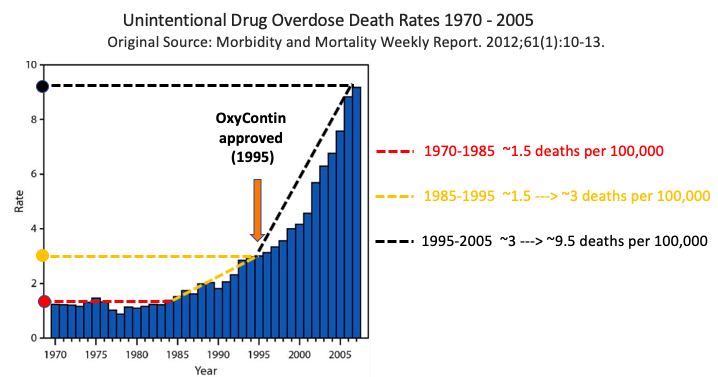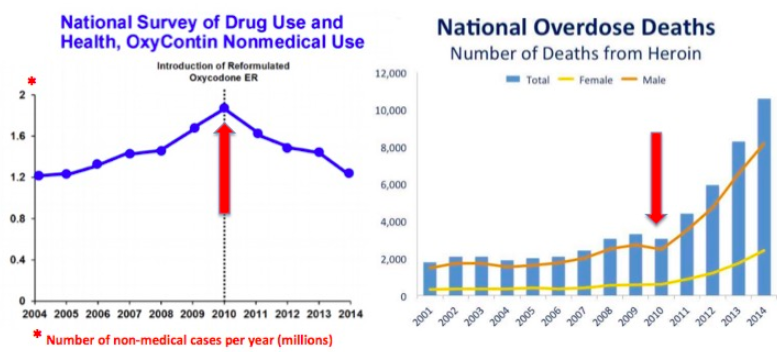#This is a companion piece to Dr. Chuck Dinerstein's From China White To Breaking Bad - The Rand Report On Fentanyl In America – an analysis of an August 2019 report by the Rand Corporation entitled "The Future of Fentanyl and Other Synthetic Opioids."
_____________________________________________________________
The Rand Corporation recently issued a 265-page report, "The Future of Fentanyl and Other Synthetic Opioids." For the most part, we agree with its findings, but not entirely. Perhaps more notable is that ACSH reached many of the same conclusions far sooner – as early as 2016 (1). Following are some examples.
HOW THE "OPIOID CRISIS" GOT STARTED
Rand (2019):
"The first wave was prescription opioids, the second wave was heroin, and the third—and ongoing—wave is synthetic opioids. … analyses of death certificate records show that most synthetic opioid overdoses as of 2016 involve fentanyl."
ACSH (2016-7):
These "waves" did not happen by chance or coincidence. They were sequential, interrelated, and predictable, if not inevitable. Furthermore, although any set of data can result in multiple interpretations, the evidence for the following scenario is strong.
- Have Opioid Restrictions Made Things Better Or Worse? (11/16)
- The Opioid Epidemic In 6 Charts Designed To Deceive You (10/17)
Wave #1: The approval of OxyContin in 1995 lit the fuse (Figure 1)
Between 1970-85 the rate of unintentional prescription opioid overdoses was low and remained constant at about 1.5 per 100,000 people. During the following decade, the rates gradually increased to 3 per 100,000 to 3. Then, Purdue's OxyContin was approved in 1995. During the following decade, what is commonly referred to as the "opioid crisis" began in full force.

Figure 1. The FDA approval of Oxycontin triggered the first wave of prescription opioid overdose deaths. Modified from original publication - MMWR (2012) 61(1):10-13
OxyContin – high dose, "pure" oxycodone (2) in an extended-release formulation – could be ground up, overcoming the extended-release properties. The resulting powder was ripe for abuse by injection or smoking. During this time what we now call the "opioid crisis" began in full force; the number of deaths more than tripled to approximately 9.5 deaths per 100,000.
Wave #2: Reformulation of OxyContin Resulted In a Surge of Heroin Use and Fatal Overdoses
Just as there can be little doubt that OxyContin was the fuel that started the fire, the approval of its reformulated version (3) in 2010 not only threw gasoline on that fire, but it was high-octane gasoline – heroin. Figure 2 (Left) shows the rapid decline in OxyContin (non-medical use) coinciding precisely with the approval with the new formulation, while at the same time, the use of far more dangerous heroin soared. The number of heroin deaths in the US rose from about 3,000 in 2010 to more than 10,000 in 2014.

Wave #3: Bad gets worse. Fentanyl arrives.
The demand for heroin, which soared from 2010-2014, was so great that fentanyl – the likes of which was never seen – filled the void beginning in 2013. The crisis then became a catastrophe.
USE VS. ABUSE
Rand (2019): "Americans consume far more opioids for medical purposes than do citizens of any other country (both in absolute and per capita terms), and, traditionally, American consumption of illegal opioids (primarily heroin) has been substantial."
ACSH (2018): "Once again, it is apparent that deaths from opioids occur from abuse, not use."
- How the feds are fueling America's opioid disaster - New York Post (12/16)
- Heads In The Sand — The Real Cause Of Today's Opioid Deaths (8/17)
- The CDC Quietly Admits It Screwed Up Counting Opioid Pills
Rand, much like the media, falsely equates the medical use of opioids with their illegal use. It has now been well established that supervised, medical use of prescription opioid analgesics rarely leads to overdose or abuse (BMJ, 2018). To say that America has an addiction because more post-surgical patients were prescribed opioid analgesics defies reality.
FENTANYL REPLACES HEROIN
Rand (2019): "Fentanyl’s potency is such that a small quantity can be easily shipped directly to buyers halfway around the world for a modest fee …A 1-kg parcel [equivalent in potency to 25-kg of heroin, can be shipped from China to the United States for as little as $10 through the international postal system."
ACSH (2017): "Given that virtually all of the fentanyl and (far worse) fentanyl analogs are being made in China, it is no surprise that Chinese authorities discovered and closed down two fentanyl factories, which had the capacity to make tons of the drug."
- Prince Was Killed By 'The Devil In The Room' (6/16)
- If You Think Fentanyl Is Bad... (1/17)
- How Chinese Organic Chemists Get Away With Murder - Literally (10/17)
Rand (2019): "Fentanyl and Other Synthetic Opioids Are Becoming Dominant in Some Parts of the United States and Canada, but Remain Less Common in Other Parts of These Countries"
ACSH (2018): "Fentanyl was involved 83% of the overdose deaths in New Hampshire ...in the Northeast, the majority of OD deaths are not from pills...The Midwest is constantly described in the news as "being ravaged by the opioid crisis." This is true, but most of the ravaging [comes from fentanyl]..."
A Little State Debunks A Big Lie: The DEA's Opioid Scam. (11/18)
Rand (2019): "…Whereas previous epidemics often were spurred by growing demand, the transition to fentanyl and other synthetic opioids appears to be a supplier-led phenomenon. …
ACSH (2017): "Fentanyl is both a drug and a murder weapon; there has never been a drug like it."
Grading The President’s Commission On Combating Drug Addiction And The Opioid Crisis (11/17)
For the most part, "The Future of Fentanyl and Other Synthetic Opioids" is an important and accurate document. Given that Rand Corporation's revenue for FY 2018 was $416 million – roughly 400-times that of ours isn't it interesting that we got there first?
NOTES:
(1) If you want to stretch it, 2013 is actually more accurate. At that time I spoke at an FDA hearing about the "opioid crisis." None of the 15 professionals and advocates even mentioned the word "fentanyl" until I got up and called it "the devil in the room." It's not clear whether they even knew what the stuff was.
(2) Unlike traditional prescription analgesics, OxyContin does not contain Tylenol (acetaminophen).
(3) Reformulated OxyContin became a "useless" gum when people tried to grind it.




